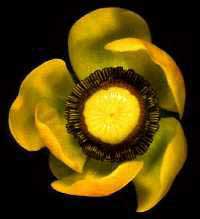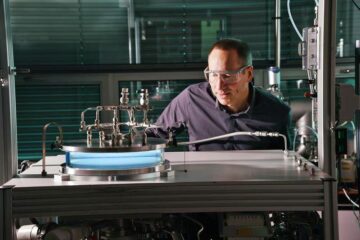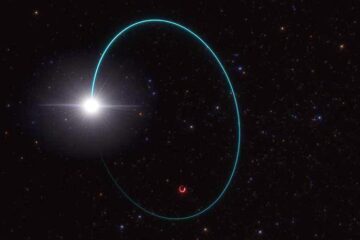Water Lily Study Sheds Light on Evolution of Flowering Plants

Image: Joseph Williams
The origin of flowering plants, or angiosperms, stands as one of evolutionary biology’s great enigmas. Scientists know that they diverged from the seed-bearing plants, or gymnosperms, at least 150 million years ago, but the details surrounding this split have proved elusive. To that end, new research into the developmental biology of an ancient lineage of flowering plants may offer insights. According to a report published today in the journal Nature, the pond lily Nuphar polysepalum (right) exhibits an intermediate form of a key angiosperm feature.
The seeds of angiosperms contain a unique tissue called endosperm, which nourishes the developing embryo. (Endosperm also represents an important source of nourishment for humans, who consume the seeds of wheat, corn, rice and barley in vast quantities.) This tissue, which forms after fertilization, usually has three copies of each chromosome: two maternal, one paternal. In scientific terms, the endosperm is triploid. Seeds of gymnosperms, in contrast, have a haploid nourishing tissue—that is, it contains only a single copy of each chromosome.
Scholars have long surmised that triploid endosperm characterized the ancestors of flowering plants. But the new study, conducted by University of Colorado biologists Joseph Williams and William Friedman, suggests otherwise. Their examinations of the DNA of Nuphar polysepalum embryo and nutritive cells revealed endosperm carrying two sets of each chromosome, one maternal and one paternal. Considering that fossil and molecular evidence place water lilies among the most ancient flowering plants, the authors suggest that their diploid endosperm may represent the ancestral condition, an intermediate form linking the haploid gymnosperms and the triploid angiosperms. „The presence of diploid endosperm in an early angiosperm lineage,“ they write, „brings us one step closer to bridging the substantial gap between flowering plants and their seed plant ancestors.“
Media Contact
Alle Nachrichten aus der Kategorie: Biowissenschaften Chemie
Der innovations-report bietet im Bereich der "Life Sciences" Berichte und Artikel über Anwendungen und wissenschaftliche Erkenntnisse der modernen Biologie, der Chemie und der Humanmedizin.
Unter anderem finden Sie Wissenswertes aus den Teilbereichen: Bakteriologie, Biochemie, Bionik, Bioinformatik, Biophysik, Biotechnologie, Genetik, Geobotanik, Humanbiologie, Meeresbiologie, Mikrobiologie, Molekularbiologie, Zellbiologie, Zoologie, Bioanorganische Chemie, Mikrochemie und Umweltchemie.
Neueste Beiträge

Merkmale des Untergrunds unter dem Thwaites-Gletscher enthüllt
Ein Forschungsteam hat felsige Berge und glattes Terrain unter dem Thwaites-Gletscher in der Westantarktis entdeckt – dem breiteste Gletscher der Erde, der halb so groß wie Deutschland und über 1000…

Wasserabweisende Fasern ohne PFAS
Endlich umweltfreundlich… Regenjacken, Badehosen oder Polsterstoffe: Textilien mit wasserabweisenden Eigenschaften benötigen eine chemische Imprägnierung. Fluor-haltige PFAS-Chemikalien sind zwar wirkungsvoll, schaden aber der Gesundheit und reichern sich in der Umwelt an….

Das massereichste stellare schwarze Loch unserer Galaxie entdeckt
Astronominnen und Astronomen haben das massereichste stellare schwarze Loch identifiziert, das bisher in der Milchstraßengalaxie entdeckt wurde. Entdeckt wurde das schwarze Loch in den Daten der Gaia-Mission der Europäischen Weltraumorganisation,…





















